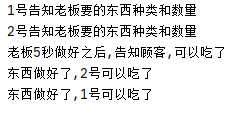等待唤醒案例代码实现和Object类中wait带参方法和notifyAll方法
等待唤醒案例代码实现
等待唤醒案例: 线程之间的通信
创建一个顾客线程(消费者):告知老板要的东西的种类和数量,调用wait方法,放弃cpu的执行,进入到WAITING状态(无限等待)
创建一个老板线程(生产者):花了5秒做东西,做好之后,调用notify方法,唤醒顾客吃东西
注意:
顾客和老板线程必须使用同步代码块包裹起来,保证等待和唤醒只能有一个在执行
同步使用的锁对象必须保证唯一
只有锁对象才能调用wait和notify方法
Object类中的方法
void wait()
在其他线程调用此对象的 notify() 方法 或 notifyAll() 方法前, 导致当前线程等待。
void notify()
唤醒在此对象监视器上等待的单个线程。
会继续执行wait方法之后的代码
public class DWaitAnd { public static void main(String[] args) { //创建锁对象,保证唯一 Object obj = new Object(); //创建一个顾客线程(消费者) new Thread(){ @Override public void run() { //保证等待和唤醒的线程只能有一个执行,需要使用同步技术 synchronized (obj){ System.out.println("告知老板要的东西种类和数量"); try { obj.wait(); } catch (InterruptedException e) { e.printStackTrace(); } //唤醒之后执行的代码 System.out.println("东西做好了,可以吃了"); } } }.start(); new Thread(){ @Override public void run() { try { //花5秒做东西 Thread.sleep(5000); } catch (InterruptedException e) { e.printStackTrace(); } synchronized (obj){ System.out.println("老板5秒做好之后,告知顾客,可以吃了"); obj.notify(); } } }.start(); } }

Object类中wait带参方法和notifyAll方法
进入到TimeWaiting(计时等待)有两种方式
1.使用sleep(long m)方法,在毫秒值结束之后,线程睡醒进入到Runnable/Blocked状态
2.使用wait(long m)方法,wait方法如果在毫秒值结束之后,还没有被notify唤醒,就会自动醒来,线程睡醒进入到Runnable/Blocked状态
唤醒的方法:
void notify() 唤醒在此对象监视器上等待的单个线程。
void notifyAll() 唤醒在此对象监视器上等待的所有线程。
notify()如果有多个线程会随机唤醒单个线程
notifyAll():
public static void main(String[] args) { //创建锁对象,保证唯一 Object obj = new Object(); //创建一个顾客线程(消费者) new Thread(){ @Override public void run() { //保证等待和唤醒的线程只能有一个执行,需要使用同步技术 synchronized (obj){ while (true){ System.out.println("1号告知老板要的东西种类和数量"); try { obj.wait(); } catch (InterruptedException e) { e.printStackTrace(); } //唤醒之后执行的代码 System.out.println("东西做好了,1号可以吃了"); } } } }.start(); new Thread(){ @Override public void run() { //保证等待和唤醒的线程只能有一个执行,需要使用同步技术 synchronized (obj){ while (true){ System.out.println("2号告知老板要的东西种类和数量"); try { obj.wait(); } catch (InterruptedException e) { e.printStackTrace(); } //唤醒之后执行的代码 System.out.println("东西做好了,2号可以吃了"); } } } }.start(); new Thread(){ @Override public void run() { while (true){ try { //花5秒做东西 Thread.sleep(5000); } catch (InterruptedException e) { e.printStackTrace(); } synchronized (obj){ System.out.println("老板5秒做好之后,告知顾客,可以吃了"); obj.notify(); } } } }.start(); }








【推荐】国内首个AI IDE,深度理解中文开发场景,立即下载体验Trae
【推荐】编程新体验,更懂你的AI,立即体验豆包MarsCode编程助手
【推荐】抖音旗下AI助手豆包,你的智能百科全书,全免费不限次数
【推荐】轻量又高性能的 SSH 工具 IShell:AI 加持,快人一步
· Manus重磅发布:全球首款通用AI代理技术深度解析与实战指南
· 被坑几百块钱后,我竟然真的恢复了删除的微信聊天记录!
· 没有Manus邀请码?试试免邀请码的MGX或者开源的OpenManus吧
· 园子的第一款AI主题卫衣上架——"HELLO! HOW CAN I ASSIST YOU TODAY
· 【自荐】一款简洁、开源的在线白板工具 Drawnix